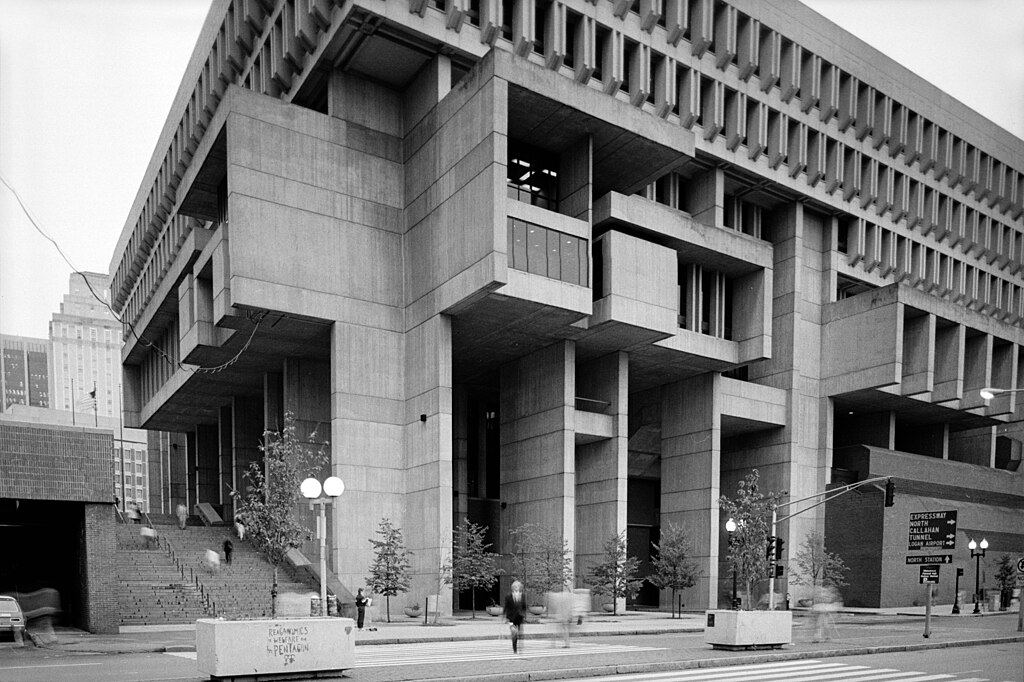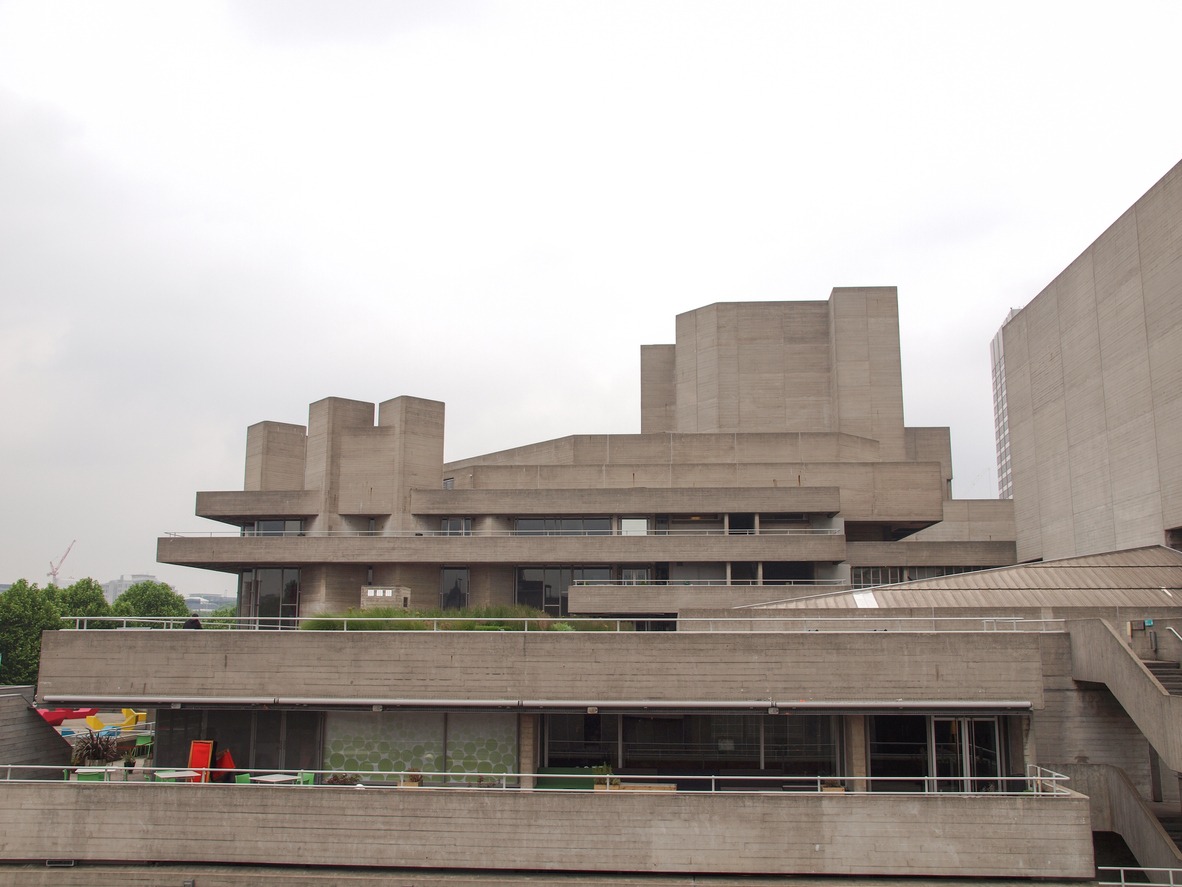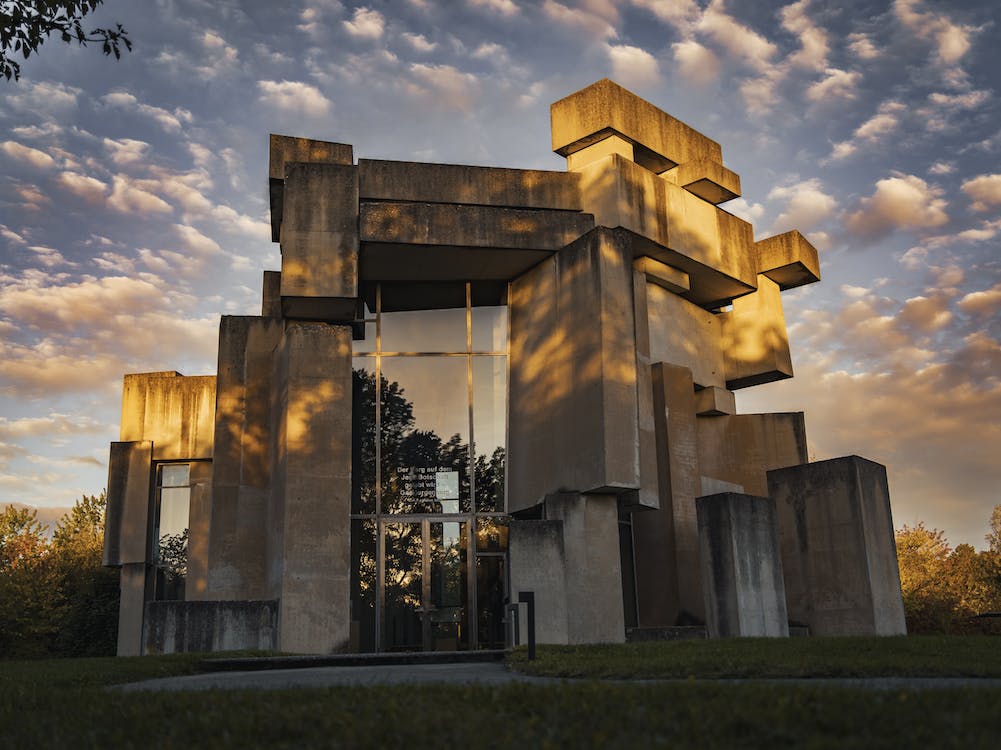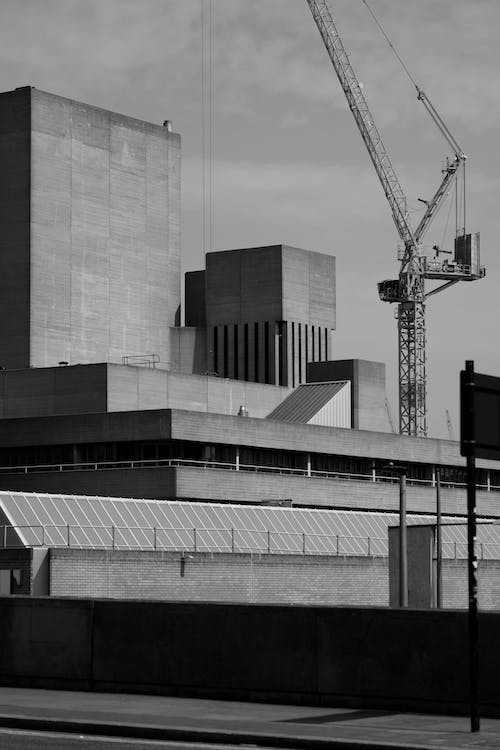Brutalist architecture, a movement that flourished from the 1950s to the mid-1970s, is known for its stark, geometric designs and extensive use of raw concrete. This architectural style emerged post-World War II, primarily in the United Kingdom, as a reaction to the lightness, optimism, and frivolity of mid-century modern design. It sought to express functionality, honesty in materials, and an unapologetic embrace of the urban environment. At the heart of Brutalist architecture is its signature material: concrete. This post explores the pivotal role concrete played in Brutalist architecture, illustrating its aesthetic, functional, and symbolic significance.
Aesthetic Appeal
The Monolithic Majesty of Concrete
The raw form of concrete imbues Brutalist buildings with a unique monolithic quality, evoking a sense of imposing majesty. This unrefined appearance, far from being a mere byproduct of construction, is a deliberate aesthetic choice. It gives Brutalist architecture its characteristic boldness, setting it apart from more polished or ornate styles. The sheer scale and solid appearance of these concrete structures make them not just buildings, but landmarks in their own right, often dominating the landscapes they inhabit.
Versatility in Form
Concrete’s adaptability is central to the architectural innovation associated with Brutalism. Before it hardens, concrete can be poured into molds of any shape, allowing architects to experiment with complex forms that would be difficult or impossible to achieve with more traditional materials. This has led to a diverse array of Brutalist structures, ranging from the angular fortress-like edifices to fluid, organic forms that challenge our perceptions of space and gravity. This versatility underpins the creativity and experimental spirit of Brutalist architecture, showcasing the material’s ability to bring visionary designs to life.
Tactile Textures
The texture of concrete in Brutalist architecture adds a significant tactile dimension to its aesthetic appeal. The technique of ‘board-marking’, where the imprints of the wooden molds are left visible on the concrete surface, creates a textured, patterned effect that is both visually intriguing and rich in tactile quality. These textures capture the essence of the building’s construction, embedding the story of its making into its very walls. This not only adds depth and character to the structures but also invites a more interactive experience, encouraging viewers to touch and feel the materiality of the building.
Dynamic Interplay with Light
Concrete’s interaction with light adds a dynamic element to Brutalist buildings, constantly altering their appearance and the way they are perceived. The rugged, textured surfaces of concrete create a play of light and shadow that shifts with the time of day and weather conditions, adding a layer of visual drama to the structures. This ever-changing interplay highlights the material’s natural variations and imperfections, celebrating its raw beauty and enhancing the visual impact of Brutalist architecture.
The aesthetic appeal of concrete in Brutalist architecture is multifaceted, encompassing its imposing scale, versatile form, tactile texture, and dynamic interplay with light. Together, these elements contribute to the distinctive and powerful presence of Brutalist buildings, marking them as enduring symbols of architectural innovation and artistic expression.
Discover more of NYC’s unique architecture. Visit New York’s Architectural Rebellion – A Journey Through a Deconstructivism Design.
Discover another Unique Theory of Architecture. Visit What is Deconstructivistic Architecture?
Functional Benefits
- Structural Integrity and Durability: Concrete’s inherent strength is one of its most valued attributes in the realm of Brutalist architecture. This robustness made it the material of choice for structures that required longevity and resilience, such as public buildings, educational institutions, and residential complexes. Concrete’s ability to withstand significant weight and pressure allowed architects to envision and construct edifices that not only reached impressive heights but also spanned wide, open spaces. This durability ensured that Brutalist buildings could endure the test of time and elements, making them stalwarts of architectural resilience.
- Spatial Flexibility: The use of concrete in Brutalist architecture brought about a revolution in interior spatial design. Its structural capabilities meant that large, uninterrupted spaces could be created without the need for internal support walls. This architectural freedom allowed for more adaptable and versatile floor plans, which could be tailored to a wide range of uses and functions. In public buildings like libraries, galleries, and auditoriums, this translated into expansive, open areas that facilitated social interaction and accessibility. In residential complexes, it allowed for innovative layouts that could accommodate evolving living standards and community needs.
- Thermal Efficiency: Another significant functional benefit of concrete is its thermal mass, which plays a crucial role in the energy efficiency of buildings. Concrete’s ability to absorb and store heat helps in moderating the internal temperature of structures. During the day, concrete walls and floors can absorb heat from sunlight, which is then gradually released as the temperature drops, reducing the need for artificial heating. Conversely, in hot climates, the cool mass of concrete interiors can absorb excess ambient heat, helping to keep indoor spaces comfortable without excessive reliance on air conditioning. This natural temperature regulation contributes to a more sustainable and energy-efficient approach to building design, aligning with contemporary concerns about environmental sustainability.
- Acoustic Properties: Concrete’s density also benefits Brutalist buildings acoustically, an aspect particularly important in institutional and communal spaces. Thick concrete walls and floors have excellent sound insulation properties, reducing the transmission of noise between spaces. This is especially advantageous in settings like libraries, where quiet is paramount, or in residential buildings, where privacy and tranquility are key. The acoustic benefits of concrete add another layer to its functional appeal, showcasing the material’s ability to create environments that are not only visually striking but also conducive to their intended use.
The functional benefits of concrete in Brutalist architecture extend far beyond its aesthetic impact. Its structural strength, spatial flexibility, thermal efficiency, and acoustic properties make concrete an incredibly versatile and practical material. These characteristics enabled the creation of buildings that were not only architecturally significant but also highly functional, serving the needs of their users with efficiency and effectiveness.
Symbolic Significance
Concrete in Brutalist architecture also carried a symbolic weight. In the post-war era, there was a desire to rebuild cities and communities with structures that conveyed solidity, stability, and permanence.
Emblem of Post-War Reconstruction
In the aftermath of World War II, the landscape of many cities was marked by destruction and the urgent need for rebuilding. Concrete, in the context of Brutalist architecture, emerged as more than just a building material; it became a symbol of the era’s resilience and determination. The raw, unadorned appearance of concrete structures communicated a sense of solidity and stability, qualities that were desperately needed in the uncertain post-war period. These buildings stood as tangible representations of a collective will to recover, rebuild, and move forward from the ravages of war, embodying the strength and endurance of the communities they served.
Honesty and Authenticity in Design
Brutalist architecture’s use of concrete also championed an ethos of honesty and authenticity in architectural design. By foregoing decorative facades and intricate ornamentation, Brutalism celebrated the ‘truth’ of materials, showcasing concrete in its most natural state. This approach was a stark departure from previous architectural styles that often relied on embellishments to convey beauty or grandeur. In Brutalist buildings, the raw texture, color, and form of concrete were left exposed, making a bold statement about valuing authenticity over adornment. This architectural honesty extended to the design of the buildings themselves, where every structural element was functional and integral to the overall form, echoing a broader cultural shift towards transparency and genuineness.
Reflection of Societal Ideals
The symbolic significance of concrete in Brutalist architecture also mirrored the societal ideals of the time, particularly the growing emphasis on communal living and social welfare. The stark, imposing structures made of concrete were often public institutions like schools, libraries, and government buildings, which played pivotal roles in community building and social services. The choice of concrete, with its associations of strength and permanence, reflected the societal commitment to investing in lasting infrastructure that would support and uplift the public. It was a material manifestation of the post-war ethos of collective effort and social responsibility, embodying the hope for a more equitable and stable society.
Aesthetic of Resilience
Furthermore, the aesthetic of concrete Brutalism—its monumental scale, fortress-like appearances, and severe lines—conveyed an unspoken narrative of resilience. In facing the existential threats of the Cold War era, Brutalist buildings seemed to offer a kind of architectural fortitude, a bulwark against both physical and ideological challenges. This resilience was not just a response to the past destruction but a defiant stance against future uncertainties, making Brutalist structures emblematic of the enduring human spirit in the face of adversity.
The symbolic significance of concrete in Brutalist architecture encapsulates a complex interplay of post-war recovery, a newfound appreciation for authenticity in design, the embodiment of communal and societal ideals, and a visual representation of resilience. These layers of meaning imbue Brutalist structures with a depth that goes beyond their physical form, making them powerful cultural and historical markers.

The Critique of Brutalism
Brutalist architecture, with its stark forms and extensive use of concrete, has long been a subject of debate and criticism. Critics often describe Brutalist buildings as cold and fortress-like, arguing that their imposing scale and raw concrete surfaces contribute to a sense of alienation and oppressiveness. This perception is compounded by the natural weathering of concrete, which can lead to a dreary and dilapidated appearance if not properly maintained.
Aesthetic Debates
The aesthetic appeal of Brutalist architecture has long been a subject of heated debate among architects, critics, and the general public. On one side of the spectrum are those who appreciate Brutalism for its raw beauty, architectural honesty, and the bold statement it makes against conventional and often ornate architectural styles. Admirers argue that Brutalist buildings, with their exposed concrete surfaces and monumental forms, embody a purity of design and an unflinching reflection of materiality and function. They see these structures not just as buildings but as sculptural works that challenge our perceptions of space and form.
Conversely, there is a significant contingent that perceives Brutalist architecture as cold, impersonal, and unwelcoming. Critics within this camp point to the heavy use of concrete and the often massive, imposing scale of Brutalist buildings as elements that contribute to a sense of alienation and intimidation among inhabitants and passersby. For these detractors, the lack of ornamentation and the stark, “unfinished” appearance of concrete surfaces symbolize a disregard for the human need for warmth, comfort, and visual stimulation in built environments.
Cultural and Social Implications
The divergent views on Brutalism extend beyond mere aesthetics, touching upon deeper cultural and social implications. Brutalist architecture, emerging in the post-war era, was often associated with progressive social housing projects, educational institutions, and government buildings. Its adoption by public sectors across the globe was not just an architectural choice but a political and ideological statement, reflecting a commitment to modernity, egalitarianism, and the welfare state. The imposing forms of Brutalist structures were meant to convey stability, durability, and a collective ethos, standing as monuments to post-war social values and aspirations.
However, as these buildings aged and societal contexts shifted, the cultural and social readings of Brutalism began to change. In some cases, the very features that were initially celebrated—such as the monumental scale and utilitarian materials—came to be seen as symbols of state overreach, surveillance, and the failures of modernist urban planning. The massive concrete edifices, designed to house utopian visions of community living and public service, sometimes ended up embodying the shortcomings of those visions, from social segregation to maintenance neglect.

Legacy and Reappraisal
Despite these criticisms, Brutalist architecture has left an indelible mark on the landscape of modern cities. Its legacy is evident not just in the surviving structures but in the ongoing influence on contemporary architecture and design. Brutalism challenged conventional notions of beauty and utility in architecture, pushing the boundaries of form and function.
In recent years, there has been a notable shift in the perception of Brutalist architecture. A growing movement among architects, historians, and enthusiasts has begun to reevaluate and celebrate the style’s contributions to architectural history and urban design. This resurgence of interest is driven by an appreciation for the raw beauty of concrete, the boldness of Brutalist forms, and the style’s expression of honesty and functionality.
Social Media and Digital Photography
Social media and digital photography have played significant roles in this reappraisal, with platforms like Instagram showcasing the dramatic interplay of light and shadow on concrete surfaces, and highlighting the sculptural quality of Brutalist buildings. This new visual context has helped to reframe Brutalism, emphasizing its aesthetic value and architectural significance.
Moreover, the historical and cultural context of Brutalist architecture is being revisited, with a deeper understanding of its role in post-war urban development and social housing. The ideals of community building, social equity, and architectural honesty that underpinned Brutalist designs are being recognized as forward-thinking and relevant to contemporary discussions about urban living and sustainable design.
Contemporary Influence
The legacy of Brutalism extends into contemporary architectural practices, with many modern architects drawing inspiration from its principles. The use of exposed materials, the exploration of monumental forms, and the integration of functional spaces into cohesive designs are all hallmarks of Brutalism that continue to resonate today. In an era increasingly focused on sustainability and authenticity, the Brutalist approach to materials and design offers valuable lessons.
While Brutalist architecture and its use of concrete have faced significant criticism, the style’s enduring influence and recent reappraisal highlight its complexity and depth. Brutalism’s legacy is a testament to the power of architectural innovation and the evolving nature of aesthetic appreciation. As society continues to grapple with issues of urbanization, sustainability, and community, the principles of Brutalism remain remarkably relevant, offering insights and inspiration for the future of architecture.
Conclusion
The exploration of concrete’s role in Brutalist architecture reveals a compelling narrative that intertwines aesthetic boldness, functional resilience, symbolic depth, and a complex legacy of both critique and admiration. This architectural movement, characterized by its raw, unadorned use of concrete, challenged conventional notions of beauty and utility, embodying post-war ideals of strength, honesty, and communal identity. Despite facing criticism for its stark, imposing forms, Brutalist architecture has witnessed a resurgence of interest, underscoring its lasting impact and the evolving appreciation for its innovative approach to design and its reflection of societal values. In this light, Brutalism stands as a testament to the enduring power of architecture to provoke thought, evoke emotion, and inspire dialogue across generations.



